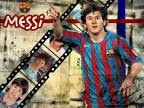FC Barcelona Information
(Last updated 28 October 2008)
INSTALLATIONS
CAMP NOU
Capacity: 98.772
Dimensions: 105x68 m.
Opened: 24th Setember 1957
MINIESTADI
Capacity: 15.276
Dimensions: 103x65 m.
Opened: 23rd Setember 1982
Sport City
Opened: 1st june 2006
Surface area: 136.839 m2
PALAU BLAUGRANA
Capacity: 7.235
Opened: 23 October 1971
Ice Rink
Capacity: 1.256
Opened: 30 octubre 1971
PALAU BLAUGRANA 2 (PICADERO)
Capacity: 1.200
Owned since April 1975
SPORTS
FOOTBALL
15 Teams
Men’s teams: Barça B, Youth A, Youth B, Cadet A, Cadet B, IChildrenA, Children B, Aleví A, Aleví B, Benjamí A and Benjamí B.
Women’s teams: Women A, Women B, Women C and Women F-7.
SECTIONS
14 sections
4 Professional sections: Basketball, handball, Roller Hockey and Indoor football
8 Non-professional sections: Guttmann-FCBarcelona (Wheelchair Basketball), athletics, rugby, Baseball, volleyball, Field Hockey, Ice Hockey and Ice Dance.
1 Associated section: and CVB Barça (Women’s Volleyball).
LOWER SECTIONS
Basketball (5 teams): Junior, Cadet A, Cadet B, Infantil A, Infantil B
Handball (5 teams): Senior B, Juvenil, Cadet A, Cadet B, Infantil
Roller hockey (4 teams): Senior B, Junior, Juvenil, Infantil
Indoor football (5 teams): Senior B, Juvenil, Cadet, Infantil.
Athletics (12 teams): Infantil, Cadet, Juvenil, Junior, Promesa and Senior male. Infantil, Cadet, Juvenil, Junior, Promesa and Senior feminine.
Rugby (9 teams): Senior A, Senior B, Juvenil, Cadet, Infantil, Aleví, Benjamí, Prebenjamí, Babies.
Baseball (6 teams): Senior A, Senior B, Juvenil, Cadet, Infantil, Aleví
Volleyball (5 teams): Senior, Junior, Juvenil, Cadet, Infantil
Field hockey (7 teams): Senior, Primera Barceloní Stick, Primera, Juvenil and Cadet male. Senior and Juvenil feminine.
Ice hockey (5 teams): Senior, Under-18, Under-13, Under-11, Under-9.
Figure skating(18 teams): Debutante (Masculino y Femenino); Jóvenes Talentos (Masculino y Femenino); Promesas Femenino; Mínima (Masculino y Femenino);Infantil (Masculino y Femenino), Novice Femenino; Junior 3ª (Masculino y Femenino); Junior 2ª (Masculino y Femenino); Junior 1ª (Masculino y Femenino). Ballet: Elit, y Jeune espoir.
CVB Barça (6 teams): Senior, Juvenil.
MEMBERS
Number of Members: 162.979
Per sexes:
Male 125.154
Female 37.825
Geographic Distribution:
Barcelona 62.710
Rest of Catalunya 79.211
Rest of Spain 21.058
OFFICIAL SUPPORTERS' CLUBS Number of Clubs: 1.888
Geographic Distribution:Zone 1 (Catalunya, Valencia, Balearic Islands andi Catalunya North): 824
Zone 2 (Spain): 920
Zone 3 (Rest of the world): 144
Active supporter’s clubs: 1.468
Geographic Distribution:Zone 1 (Catalunya, Valencia, Balearic Islands andi Catalunya North): 651
Zone 2 (Espanya): 711
Zone 3 (Rest of the world): 106
